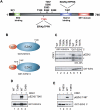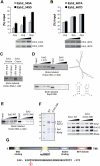Phosphorylation of the PRC2 component Ezh2 is cell cycle-regulated and up-regulates its binding to ncRNA - PubMed (original) (raw)
Phosphorylation of the PRC2 component Ezh2 is cell cycle-regulated and up-regulates its binding to ncRNA
Syuzo Kaneko et al. Genes Dev. 2010.
Abstract
Ezh2 functions as a histone H3 Lys 27 (H3K27) methyltransferase when comprising the Polycomb-Repressive Complex 2 (PRC2). Trimethylation of H3K27 (H3K27me3) correlates with transcriptionally repressed chromatin. The means by which PRC2 targets specific chromatin regions is currently unclear, but noncoding RNAs (ncRNAs) have been shown to interact with PRC2 and may facilitate its recruitment to some target genes. Here we show that Ezh2 interacts with HOTAIR and Xist. Ezh2 is phosphorylated by cyclin-dependent kinase 1 (CDK1) at threonine residues 345 and 487 in a cell cycle-dependent manner. A phospho-mimic at residue 345 increased HOTAIR ncRNA binding to Ezh2, while the phospho-mimic at residue 487 was ineffectual. An Ezh2 domain comprising T345 was found to be important for binding to HOTAIR and the 5' end of Xist.
Figures
Figure 1.
CDK1 phosphorylates Ezh2 in vitro. (A) Phosphorylation sites of mouse Ezh2. Previously identified phosphorylation sites are shown above the schematic (black letters). A newly identified phosphorylation site (T345 residue) is shown below the schematic (red letter). The amino acid sequences surrounding the two phosphorylated threonine residues T345 and T487 are shown. Eed- and SUZ12-binding sites and the SET domain are indicated. (B) Schematic of the GST fusion proteins containing truncated Ezh2 ([GST-Ezh2 N] N-terminal-truncated; [GST-Ezh2 C] C-terminal-truncated) used for in vitro kinase assays. Phosphorylated threonine sites are indicated. (C, top panel) In vitro CDK1 kinase assays containing [γ-32P] ATP and the single mutant Ezh2 proteins are indicated on top. (Bottom panel) Input proteins were probed with α-GST antibody. The asterisk indicates auto-phosphorylated cyclin B. (D,E) As in B, but using cold ATP. Phosphorylated Ezh2 was detected by immunoblot using phospho-specific antibodies.
Figure 2.
Ezh2 is phosphorylated by the mitotic CDK in vivo. (A) T345 and T487 of Ezh2 are phosphorylated mainly during the mitotic phase. Cells released from G1 arrest after a double-thymidine block were sampled every 2 h, and NEs were subjected to Western analyses using the antibodies indicated on the right. (B) The effect of CDK inhibitors on Ezh2 phosphorylation. HeLa cells were treated for 12 h with DMSO, 200 μM olomoucine, 20 μM roscovitine, or 50 μM etoposide. NEs were subjected to Western analyses using the antibodies indicated on the right. (C) In vitro HMKT assays of PRC2 complex containing the indicated Ezh2 mutants. Indicated amounts of PRC2 complexes were incubated with buffer containing 1 μg of recombinant nucleosomes and 1 μM 3H-SAM for 60 min. The signals were quantified by scintillation counter. (D) Western blot analysis of increasing amounts of PRC2-Ezh2 mutants using the antibodies indicated on the right.
Figure 3.
Phospho-mimic Ezh2 at T345 preferentially binds to HOTAIR ncRNA in vitro. (A,B, bottom panels) Coomassie blue staining of SDS-PAGE analysis of increasing amounts of Flag tag affinity-purified Ezh2 mutants, as indicated on the right, isolated from Sf9 cells. (Top panels) Bar graphs showing the quantification by scintillation counting of P32-5′ end-labeled HOTAIR ncRNA bound to affinity-purified Ezh2. HOTAIR ncRNA was incubated with the indicated amounts of the affinity-purified Ezh2 mutants, then purified using anti-Flag M2 affinity beads. (C) Biotin-labeled HOTAIR ncRNAs were incubated with 4 μg of GST-Ezh2 N or GST-Ezh2 C proteins. Ezh2 bound to HOTAIR ncRNA was purified by Streptavidin beads and was detected by SDS-PAGE. (D) As in C, but using increasing amounts (2, 4, and 6 μg) of GST-Ezh2 1–370 or GST-Ezh2 1–341 with biotin-labeled HOTAIR ncRNA (top) or RepA RNA (bottom). The right side shows the computationally predicted structure of HOTAIR ncRNA (top) and the structure of one repeat of RepA RNA (bottom), as indicated. (E) As in C, but using increasing amounts (2, 4, and 6 μg) of full-length Ezh2, either wild type or mutant (deletion of 342–368 amino acids), as indicated. (F, left panel) Coomassie blue staining of SDS-PAGE analysis of Flag tag affinity-purified PRC2 complex isolated from Sf9 cells and containing Ezh2, either wild type or deletion mutant, as indicated. (Right panel) Western analysis of increasing amounts of affinity-purified PRC2 complex containing the indicated Ezh2 component, using the antibodies indicated on the right. (G) Domain structure of Ezh2. A newly identified domain (ncRBD1) required for ncRNA binding and containing the T345 phosphorylation site is shown in yellow. The amino acid sequence of ncRBD1 is shown below.
Figure 4.
Phospho-mimic Ezh2 at T345 preferentially binds to HOTAIR ncRNA in vivo. (A) Cotransfection of 293 cells with the Ezh2 mutants indicated and HOTAIR ncRNA. Transiently overexpressed Ezh2 proteins were detected by anti-Flag antibody, and CPSF-100 served as a loading control. (B) Bar graph of results from qRT–PCR of HOTAIR ncRNA bound to Ezh2 protein. Signals were normalized by the total amount of HOTAIR ncRNA in each case. (N.D.) Not detected. (C) Western analysis of stably expressed GFP-Ezh2 mutants and endogenous Ezh2 in HeLa cells using anti-Ezh2 antibody. (D) Results of RT–PCR performed on HOTAIR ncRNA bound to GFP-Ezh2 protein. PCR products were detected by qRT–PCR. (Bottom) Bar graph of qRT–PCR results for HOTAIR ncRNA with signals normalized by the total amounts of HOTAIR ncRNA in each case.
Similar articles
- Phosphorylation of EZH2 by CDK1 and CDK2: a possible regulatory mechanism of transmission of the H3K27me3 epigenetic mark through cell divisions.
Zeng X, Chen S, Huang H. Zeng X, et al. Cell Cycle. 2011 Feb 15;10(4):579-83. doi: 10.4161/cc.10.4.14850. Epub 2011 Feb 15. Cell Cycle. 2011. PMID: 21278485 Free PMC article. - CDK1-dependent phosphorylation of EZH2 suppresses methylation of H3K27 and promotes osteogenic differentiation of human mesenchymal stem cells.
Wei Y, Chen YH, Li LY, Lang J, Yeh SP, Shi B, Yang CC, Yang JY, Lin CY, Lai CC, Hung MC. Wei Y, et al. Nat Cell Biol. 2011 Jan;13(1):87-94. doi: 10.1038/ncb2139. Epub 2010 Dec 5. Nat Cell Biol. 2011. PMID: 21131960 Free PMC article. - The phosphatase interactor NIPP1 regulates the occupancy of the histone methyltransferase EZH2 at Polycomb targets.
Van Dessel N, Beke L, Görnemann J, Minnebo N, Beullens M, Tanuma N, Shima H, Van Eynde A, Bollen M. Van Dessel N, et al. Nucleic Acids Res. 2010 Nov;38(21):7500-12. doi: 10.1093/nar/gkq643. Epub 2010 Jul 29. Nucleic Acids Res. 2010. PMID: 20671031 Free PMC article. - Inner workings and regulatory inputs that control Polycomb repressive complex 2.
O'Meara MM, Simon JA. O'Meara MM, et al. Chromosoma. 2012 Jun;121(3):221-34. doi: 10.1007/s00412-012-0361-1. Epub 2012 Feb 19. Chromosoma. 2012. PMID: 22349693 Free PMC article. Review. - EZH2 methyltransferase and H3K27 methylation in breast cancer.
Yoo KH, Hennighausen L. Yoo KH, et al. Int J Biol Sci. 2012;8(1):59-65. doi: 10.7150/ijbs.8.59. Epub 2011 Nov 18. Int J Biol Sci. 2012. PMID: 22211105 Free PMC article. Review.
Cited by
- Re-analysis of CLAP data affirms PRC2 as an RNA binding protein.
Lee Y, Blum R, Rosenberg M, Lee JT. Lee Y, et al. bioRxiv [Preprint]. 2024 Sep 20:2024.09.19.613009. doi: 10.1101/2024.09.19.613009. bioRxiv. 2024. PMID: 39345380 Free PMC article. Preprint. - Role of EZH2-mediated epigenetic modification on vascular smooth muscle in cardiovascular diseases: A mini-review.
Luo H, Li Y, Song H, Zhao K, Li W, Hong H, Wang YT, Qi L, Zhang Y. Luo H, et al. Front Pharmacol. 2024 Jun 27;15:1416992. doi: 10.3389/fphar.2024.1416992. eCollection 2024. Front Pharmacol. 2024. PMID: 38994197 Free PMC article. Review. - The multifaceted functions of long non-coding RNA HOTAIR in neuropathologies and its potential as a prognostic marker and therapeutic biotarget.
Ahmad F, Sudesh R, Ahmed AT, Arumugam M, Mathkor DM, Haque S. Ahmad F, et al. Expert Rev Mol Med. 2024 Apr 29;26:e11. doi: 10.1017/erm.2024.11. Expert Rev Mol Med. 2024. PMID: 38682637 Free PMC article. Review. - Morphological Changes Induced by TKS4 Deficiency Can Be Reversed by EZH2 Inhibition in Colorectal Carcinoma Cells.
Jacksi M, Schad E, Tantos A. Jacksi M, et al. Biomolecules. 2024 Apr 5;14(4):445. doi: 10.3390/biom14040445. Biomolecules. 2024. PMID: 38672463 Free PMC article.
References
- Cha TL, Zhou BP, Xia W, Wu Y, Yang CC, Chen CT, Ping B, Otte AP, Hung MC 2005. Akt-mediated phosphorylation of EZH2 suppresses methylation of lysine 27 in histone H3. Science 310: 306–310 - PubMed
Publication types
MeSH terms
Substances
LinkOut - more resources
Full Text Sources
Other Literature Sources
Molecular Biology Databases
Miscellaneous



